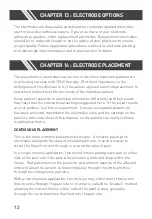
3
CHAPTER 1 : INTRODUCTION
EXPLANATION OF PAIN
Pain is a warning system and the body’s method of telling us that something
is wrong. Pain is important; without it abnormal conditions may go
undetected, causing damage or injury to vital parts of our bodies.
Even though pain is a necessary warning signal of trauma or malfunction in
the body, nature may have gone too far in its design. Aside from its value in
diagnosis, long-lasting persistent pain serves no useful purpose. Pain does
not begin until a coded message travels to the brain where it is decoded,
analyzed, and then reacted to. The pain message travels from the injured
area along the small nerves leading to the spinal cord. Here the message is
switched to different nerves that travel up the spinal cord to the brain. The
pain message is then interpreted, referred back and the pain is felt.
EXPLANATION OF TENS
Transcutaneous Electrical Nerve Stimulation is a non-invasive, drug free
method of controlling pain. TENS uses tiny electrical impulses sent through
the skin to nerves to modify your pain perception. TENS does not cure any
physiological problem; it only helps control the pain. TENS does not work for
everyone; however, in most patients it is effective in reducing or eliminating
the pain, allowing for a return to normal activity.
HOW TENS WORKS
There is nothing “magic” about Transcutaneous Electrical Nerve Stimulation
(TENS). TENS is intended to be used to relieve pain. The TENS unit sends
comfortable impulses through the skin that stimulate the nerve (or nerves)
in the treatment area. In many cases, this stimulation will greatly reduce or
eliminate the pain sensation the patient feels. Pain relief varies by individual
patient, mode selected for therapy, and the type of pain. In many patients,
the reduction or elimination of pain lasts longer than the actual period of
stimulation (sometimes as much as three to four times longer). In others,
pain is only modified while stimulation actually occurs. You may discuss this
with your physician or therapist.




































